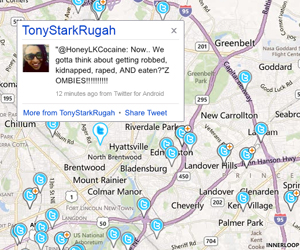 The Microsoft Corporation is taking on it’s arch rival, Google, in a virtual showdown at the HTTP Corral. Law enforcement is going to win big no matter who wins this social media fistfight. Microsoft has been ensconcing itself firmly in both Facebook and Twitter search and Google for a change, must play catch-up. Microsoft has provided law enforcement with tools that can help gather information faster and in real-time. If you didn’t believe in social media as a viable law enforcement investigative tool, Microsoft may have just change your mind.
The Microsoft Corporation is taking on it’s arch rival, Google, in a virtual showdown at the HTTP Corral. Law enforcement is going to win big no matter who wins this social media fistfight. Microsoft has been ensconcing itself firmly in both Facebook and Twitter search and Google for a change, must play catch-up. Microsoft has provided law enforcement with tools that can help gather information faster and in real-time. If you didn’t believe in social media as a viable law enforcement investigative tool, Microsoft may have just change your mind.
Awhile back I wrote an article on ConnectedCops.net entitled, The Social Media Canvass. In it, I explained the importance of checking social media sites for information in addition to conducting the traditional investigative canvasses once the detectives arrive at the scene. The social media canvass has changed the way we conduct investigations, how law enforcement views electronic intelligence and how it uses smartphones / tablets at the scene of a major incident. Law enforcement has always been slow to adopt anything new, however, at the speed that technology is developing in the social media space, we may find ourselves in a hole that may be to deep to dig out of.
The Microsoft Bing Map Twitter App can provide a treasure trove of intelligence for law enforcement, quickly and more efficiently, by tapping into it’s Twitter Map App. The app can be found from the Bing.com homepage by clicking on the Maps link, choosing Map Apps and scrolling down to the Twitter App (Currently there are 59 Apps in alphabetical order). Once the app has loaded, two tabs, Timeline and Search, appear on the left side of the screen. When you click on the Search tab, you are able to enter a location, address or landmark, keyword or phrase or a Twitter username. Since you will probably not be looking for anyone in particular, enter text in the location and keyword boxes. For example, enter your hometown in the location box and shooting, murder, rape, robbery, etc. in the keywords / phrases box. Within a few seconds, Bing will locate all Tweets that contain that information and provide the investigator with a map of where the person Tweeted from or is currently tweeting from, as well as a Timeline that is updated with every new Tweet that contains your parameters. More importantly, it provides active links directly to the person’s Twitter account-which means you know who they follow and who follows them.
Google will need to create something even better if it wants to stay relevant in the social media search space. This virtual fight will only benefit law enforcement. As the two Internet giants battle it out, they will create better tools for us to use. Microsoft’s Bing is already Facebook’s default search engine, so investigators should go there first to conduct their initial searches during the social media canvass. Twitter, the “other social media site” is currently building a sizable user base of over 465 million. Law enforcement can use Bing to tap into this growing database and identify tweets timely, which may lead to more actionable intelligence and more closed cases.
Remember, it is not only bad guys that we are looking for when we use the social media canvass. We can identify eye and ear witnesses and obtain intelligence information that may prove or disprove alibis.

